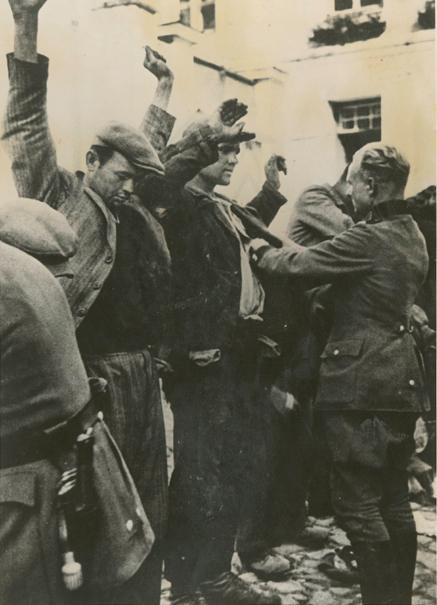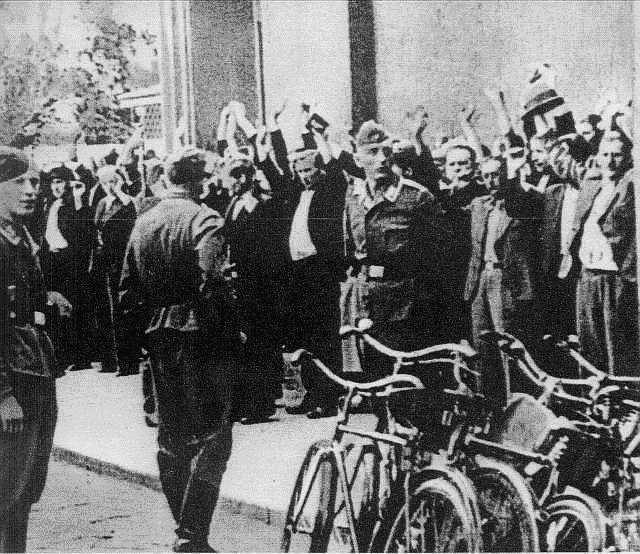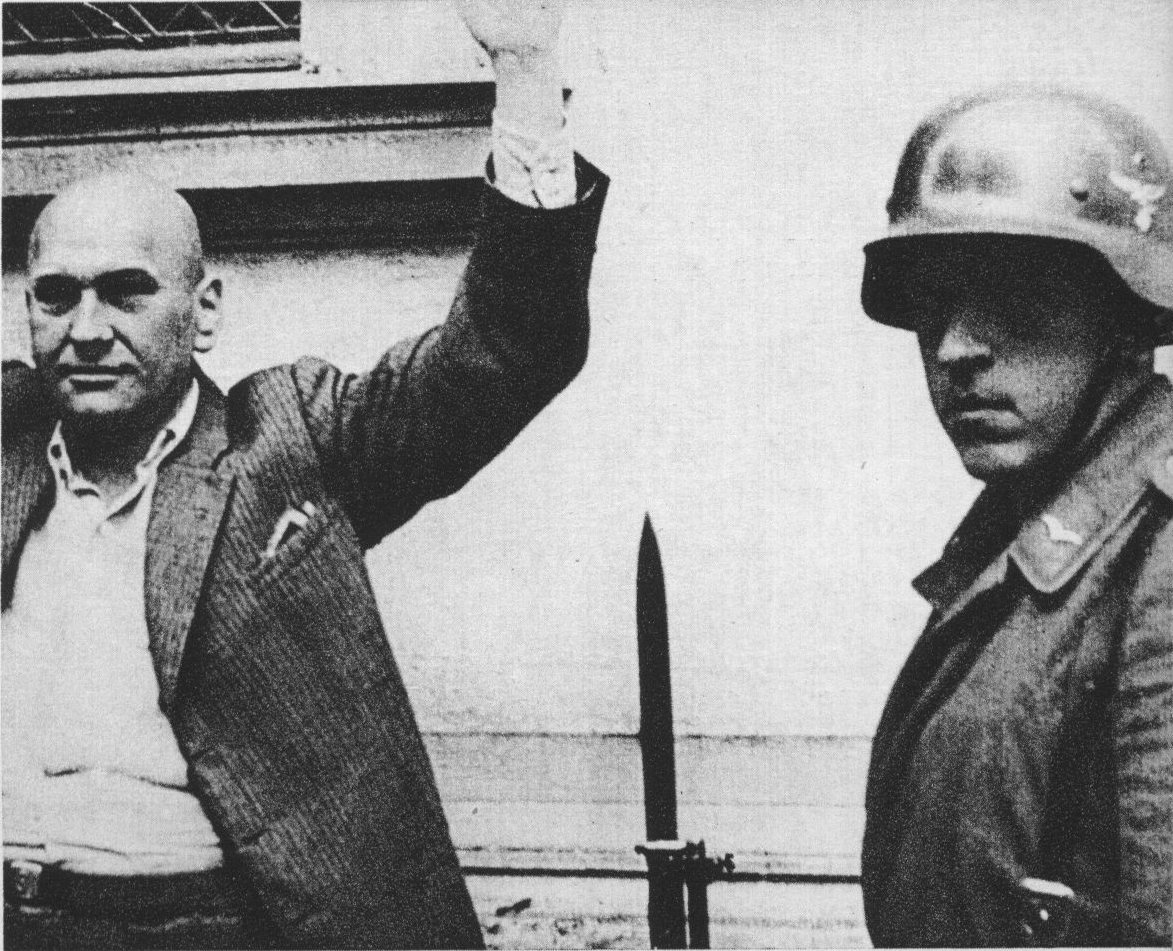Łapanka on:
[Wikipedia]
[Google]
[Amazon]
''Łapanka'' () was the Polish name for a
 The term ''łapanka'', derived from the Polish verb ''łapać'' ("to catch"), carried a
The term ''łapanka'', derived from the Polish verb ''łapać'' ("to catch"), carried a  Most people who were rounded up were transported to labour camps (''
Most people who were rounded up were transported to labour camps ('' According to estimates, in Warsaw alone between 1942 and 1944 the Nazi ''łapankas'' claimed at least 400 victims every day, with numbers reaching several thousand on some days. On 19 September 1942, nearly 3,000 men and women, who had been caught in massive round-ups all over Warsaw during the previous two days, were transported by train-loads to slave labour in Nazi-Germany.
According to estimates, in Warsaw alone between 1942 and 1944 the Nazi ''łapankas'' claimed at least 400 victims every day, with numbers reaching several thousand on some days. On 19 September 1942, nearly 3,000 men and women, who had been caught in massive round-ups all over Warsaw during the previous two days, were transported by train-loads to slave labour in Nazi-Germany.
 Such roundups as Poland's ''łapanka'' were carried out by the
Such roundups as Poland's ''łapanka'' were carried out by the
Europe: A History
', Oxford University Press, pp. 1002-3. .
 In 1940, one roundup was used by
In 1940, one roundup was used by
Google Print, p.413
/ref>
 In retribution for roundups as acts of Nazi terror, the Polish resistance carried out attacks on Nazi forces and prepared lists of Nazi leaders to be eliminated for their crimes against civilians. Nazi personnel responsible for organizing roundups, such as members of local unemployment offices, the SS, SD, and Nazi police, were sentenced to death by the
In retribution for roundups as acts of Nazi terror, the Polish resistance carried out attacks on Nazi forces and prepared lists of Nazi leaders to be eliminated for their crimes against civilians. Nazi personnel responsible for organizing roundups, such as members of local unemployment offices, the SS, SD, and Nazi police, were sentenced to death by the
World War II
World War II or the Second World War, often abbreviated as WWII or WW2, was a world war that lasted from 1939 to 1945. It involved the vast majority of the world's countries—including all of the great powers—forming two opposing ...
practice in German-occupied Poland
' ( Norwegian: ') is a Norwegian political thriller TV series that premiered on TV2 on 5 October 2015. Based on an original idea by Jo Nesbø, the series is co-created with Karianne Lund and Erik Skjoldbjærg. Season 2 premiered on 10 Octobe ...
, whereby the German SS, Wehrmacht
The ''Wehrmacht'' (, ) were the unified armed forces of Nazi Germany from 1935 to 1945. It consisted of the ''Heer'' (army), the '' Kriegsmarine'' (navy) and the ''Luftwaffe'' (air force). The designation "''Wehrmacht''" replaced the previo ...
and Gestapo
The (), abbreviated Gestapo (; ), was the official secret police of Nazi Germany and in German-occupied Europe.
The force was created by Hermann Göring in 1933 by combining the various political police agencies of Prussia into one orga ...
rounded up civilians on the streets of Polish cities. The civilians to be arrested were in most cases chosen at random from among passers-by or inhabitants of city quarters surrounded by German forces prior to the action.
The term usually refers to the action of rounding up and arresting a number of random people. Those caught in a ''łapanka'' were either taken hostage, arrested, sent to labor camps or concentration camps, or summarily executed.
Those caught in roundups were most often sent to slave labour in Nazi Germany, but some were also taken as hostages or executed in reprisal actions; imprisoned and sent to concentration camps or summarily executed in numerous ethnic-cleansing operations.
History
 The term ''łapanka'', derived from the Polish verb ''łapać'' ("to catch"), carried a
The term ''łapanka'', derived from the Polish verb ''łapać'' ("to catch"), carried a sardonic
To be sardonic is to be disdainfully or cynically humorous, or scornfully mocking.
A form of wit or humour, being sardonic often involves expressing an uncomfortable truth in a clever and not necessarily malicious way, often with a degree of sk ...
connotation due to the prior use of the word ''łapanka'' for the children's game known in English as " tag".
 Most people who were rounded up were transported to labour camps (''
Most people who were rounded up were transported to labour camps (''Arbeitslager
''Arbeitslager'' () is a German language word which means labor camp. Under Nazism, the German government (and its private-sector, Axis, and collaborator partners) used forced labor extensively, starting in the 1930s but most especially durin ...
'') or concentration camps, including Auschwitz. Many Polish women were selected for sexual slavery. Many Polish children were kidnapped for adoption by German families. Some − those without proper documents or carrying contraband − were transported to concentration
In chemistry, concentration is the abundance of a constituent divided by the total volume of a mixture. Several types of mathematical description can be distinguished: '' mass concentration'', ''molar concentration'', '' number concentration'', ...
and death camp
Nazi Germany used six extermination camps (german: Vernichtungslager), also called death camps (), or killing centers (), in Central Europe during World War II to systematically murder over 2.7 million peoplemostly Jewsin the Holocaust. The v ...
s. Others, particularly Jews in hiding and Poles wanted for harboring them, were shot dead on the spot.
The term was also used for describing the tactic of cordoning-off of streets, and the systematic searching of buildings. For young men in their 20s and 30s, the only reliable defense against being taken away by the Nazis was the possession of an identity card (called ''Ausweis'') certifying that the holder was employed by a Nazi-German company or a government agency locally (for example, by the city utilities or the railways). Thus, many of those who were taken from cafes and restaurants in Warsaw
Warsaw ( pl, Warszawa, ), officially the Capital City of Warsaw,, abbreviation: ''m.st. Warszawa'' is the capital and largest city of Poland. The metropolis stands on the River Vistula in east-central Poland, and its population is officia ...
on the night of December 5, 1940 were subsequently released after their documents had been checked.
 According to estimates, in Warsaw alone between 1942 and 1944 the Nazi ''łapankas'' claimed at least 400 victims every day, with numbers reaching several thousand on some days. On 19 September 1942, nearly 3,000 men and women, who had been caught in massive round-ups all over Warsaw during the previous two days, were transported by train-loads to slave labour in Nazi-Germany.
According to estimates, in Warsaw alone between 1942 and 1944 the Nazi ''łapankas'' claimed at least 400 victims every day, with numbers reaching several thousand on some days. On 19 September 1942, nearly 3,000 men and women, who had been caught in massive round-ups all over Warsaw during the previous two days, were transported by train-loads to slave labour in Nazi-Germany.Władysław Bartoszewski
Władysław Bartoszewski (; 19 February 1922 – 24 April 2015) was a Polish politician, social activist, journalist, writer and historian. A former Auschwitz concentration camp prisoner, he was a World War II resistance fighter as part of th ...
, ''1859 dni Warszawy'' (1859 Days of Warsaw), pp. 303-4.
Targeted territories
 Such roundups as Poland's ''łapanka'' were carried out by the
Such roundups as Poland's ''łapanka'' were carried out by the Germans
, native_name_lang = de
, region1 =
, pop1 = 72,650,269
, region2 =
, pop2 = 534,000
, region3 =
, pop3 = 157,000
3,322,405
, region4 =
, pop4 = ...
in other occupied countries as well, particularly in northern France
France (), officially the French Republic ( ), is a country primarily located in Western Europe. It also comprises of overseas regions and territories in the Americas and the Atlantic, Pacific and Indian Oceans. Its metropolitan area ...
, although not as extensively as in Poland. The French term for this practice was ''rafle'', applied primarily to the rounding-up of French Jew
Jews ( he, יְהוּדִים, , ) or Jewish people are an ethnoreligious group and nation originating from the Israelites Israelite origins and kingdom: "The first act in the long drama of Jewish history is the age of the Israelites""T ...
s. In Denmark and the Netherlands, a Nazi roundup was called ''razzia''.
In historical terms, the '' razzia'' roundup was used in French colonial
French colonial architecture includes several styles of architecture used by the French during colonization. Many former French colonies, especially those in Southeast Asia, have previously been reluctant to promote their colonial architectur ...
context for Muslim raids particularly to plunder and capture slaves from Western and Central Africa, also known as ''rezzou'' when practiced by the Tuareg
The Tuareg people (; also spelled Twareg or Touareg; endonym: ''Imuhaɣ/Imušaɣ/Imašeɣăn/Imajeɣăn'') are a large Berber ethnic group that principally inhabit the Sahara in a vast area stretching from far southwestern Libya to southern Alg ...
. (See also: Barbary slave trade
The Barbary slave trade involved slave markets on the Barbary Coast of North Africa, which included the Ottoman states of Algeria, Tunisia and Tripolitania and the independent sultanate of Morocco, between the 16th and 19th century. The Ottom ...
) The word was adopted from ''ġaziya'' of Algerian Arabic
Algerian Arabic (natively known as Dziria) is a dialect derived from the form of Arabic spoken in northern Algeria. It belongs to the Maghrebi Arabic language continuum and is partially mutually intelligible with Tunisian and Moroccan.
Like ...
vernacular and later became a figurative name for any act of pillage, with its verb form ''razzier''. The Soviet
The Soviet Union,. officially the Union of Soviet Socialist Republics. (USSR),. was a transcontinental country that spanned much of Eurasia from 1922 to 1991. A flagship communist state, it was nominally a federal union of fifteen nation ...
s used similar tactics to round up middle-class Poles in the part of Poland that they occupied following the 1939 invasion of Poland
The invasion of Poland (1 September – 6 October 1939) was a joint attack on the Republic of Poland by Nazi Germany and the Soviet Union which marked the beginning of World War II. The German invasion began on 1 September 1939, one week aft ...
. Men, women, and children were transported to labour camp
A labor camp (or labour camp, see spelling differences) or work camp is a detention facility where inmates are forced to engage in penal labor as a form of punishment. Labor camps have many common aspects with slavery and with prisons (especi ...
s in remote regions of the Soviet Union. Norman Davies (1996), Europe: A History
', Oxford University Press, pp. 1002-3. .
Polish resistance
 In 1940, one roundup was used by
In 1940, one roundup was used by Home Army
The Home Army ( pl, Armia Krajowa, abbreviated AK; ) was the dominant resistance movement in German-occupied Poland during World War II. The Home Army was formed in February 1942 from the earlier Związek Walki Zbrojnej (Armed Resistance) est ...
secret agent Witold Pilecki
Witold Pilecki (13 May 190125 May 1948; ; codenames ''Roman Jezierski, Tomasz Serafiński, Druh, Witold'') was a Polish World War II cavalry officer, intelligence agent, and resistance leader.
As a youth, Pilecki joined Polish underground s ...
to gain entry into the Auschwitz camp set up at about that time for Polish prisoners. There, he gathered first-hand intelligence on the camp, and organised inmate resistance. Pilecki deliberately went out into the street during a Warsaw roundup on 19 September 1940, and was arrested by the Nazis along with other civilians. Auschwitz was the main destination for the Poles from beyond the ghetto. There he organised '' Związek Organizacji Wojskowej'' (''ZOW'', the Military Organization Association), and in November 1940 sent its first report about the camp and the genocide being committed there to Home Army headquarters in Warsaw.Hershel Edelheit, ''History of the Holocaust: A Handbook and Dictionary'', Westview Press, 1994,Google Print, p.413
/ref>

 In retribution for roundups as acts of Nazi terror, the Polish resistance carried out attacks on Nazi forces and prepared lists of Nazi leaders to be eliminated for their crimes against civilians. Nazi personnel responsible for organizing roundups, such as members of local unemployment offices, the SS, SD, and Nazi police, were sentenced to death by the
In retribution for roundups as acts of Nazi terror, the Polish resistance carried out attacks on Nazi forces and prepared lists of Nazi leaders to be eliminated for their crimes against civilians. Nazi personnel responsible for organizing roundups, such as members of local unemployment offices, the SS, SD, and Nazi police, were sentenced to death by the Special Courts
An extraordinary court, or special court, is a type of court that is established outside of ordinary judiciary, composed of irregularly selected judges or applies irregular procedure for judgment. Since extraordinary court can be abused to infrin ...
of the Polish Underground for crimes against Polish citizens during the Occupation of Poland
Occupation commonly refers to:
* Occupation (human activity), or job, one's role in society, often a regular activity performed for payment
*Occupation (protest), political demonstration by holding public or symbolic spaces
*Military occupation, t ...
. Because of the particular brutality of the police, the AK killed 361 gendarmes in 1943, and 584 in 1944. In Warsaw alone, ten Nazis were killed daily. From August to December 1942, the AK launched 87 attacks on the Nazi administration and members of the apparatus of terror. In 1943 this number rose radically − the AK carried out 514 attacks during the first four months. In an underground operation known as Operacja Główki (Operation Heads), Polish underground combat units from Kedyw eliminated roundup organizers such as:
#Kurt Hoffman - chief of the unemployment office in Warsaw responsible for organising roundups of Poles. Executed by the AK on 9 April 1943.
#Hugo Dietz - Hoffmann's assistant. Executed on 13 April 1943.
#Fritz Geist - chief of the unemployment office department. Killed on 10 May 1943.
#Willi Lübbert - worked at the unemployment office and organised roundups of Poles to be sent to Nazi labor camps. Executed on 1 July 1944.
#Eugen Bollodino - worked at the unemployment office and organised roundups of Poles to be sent to Nazi labor camps. Executed by combat patrol unit DB-17 on 8 June 1944.
In culture
Criticism of the Nazi practice of roundups was the theme of the most popular song of occupied Warsaw, Siekiera, motyka (Polish for ''Axe, Hoe'').Stanisław Salmonowicz, ''Polskie Państwo Podziemne'', Wydawnictwa Szkolne i Pedagogiczne, Warszawa, 1994, , p.255 In 1943 it was published by the Polish resistance's underground presses in the book ''Posłuchajcie ludzie...'' (Listen, folks), one of the ''bibuła
Polish underground press, devoted to prohibited materials ( sl. pl, bibuła, lit. semitransparent blotting paper or, alternatively, pl, drugi obieg, lit. second circulation), has a long history of combatting censorship of oppressive regimes in ...
'' publications of the ''Komisja Propagandy'' (Propaganda Commission) of the '' Armia Krajowa'' (Home Army). The song was also reproduced in several books and records after the Nazi occupation ended. In 1946 the song was featured in the first Polish movie created after the war, '' Zakazane piosenki'', directed by Leonard Buczkowski.
See also
*Chronicles of Terror
Chronicles of Terror is a digital internet archive established by the in August 2016. Initially, it provided access to the depositions of Polish citizens who after World War II were interviewed as witnesses before the Main Commission for the Inve ...
* Forced labour under German rule during World War II
* German camps in occupied Poland during World War II
* War crimes in occupied Poland during World War II
* Nazi crimes against the Polish nation
Crimes against the Polish nation committed by Nazi Germany and Axis collaborationist forces during the invasion of Poland, along with auxiliary battalions during the subsequent occupation of Poland in World War II, consisted of the murder of ...
Notes
References
References
*Władysław Bartoszewski
Władysław Bartoszewski (; 19 February 1922 – 24 April 2015) was a Polish politician, social activist, journalist, writer and historian. A former Auschwitz concentration camp prisoner, he was a World War II resistance fighter as part of th ...
, ''1859 dni Warszawy'' (1859 Days of Warsaw), Kraków, 1974.
* Norman Davies, ''Europe: A History'', .
* Ron Jeffery
Ronald Clarence Jeffery (6 September 1917 – 24 September 2002), also Józef Kawala, Stanisław Jasiński, Sporn and Botkin, was an English soldier and an agent of British intelligence, British and History of Polish intelligence services#1939.E ...
, "Red Runs the Vistula", Nevron Associates Publ.,Manurewa, Auckland, New Zealand 1985
* Richard C. Lukas "Forgotten Holocaust - The Poles Under German Occupation 1939-1944" Hippocrene Books 1997
* Tomasz Strzembosz, ''Akcje zbrojne podziemnej Warszawy 1939-1944'', Warszawa, 1978.
* Stachiewicz Piotr, ''Akcja "Kutschera"'', Książka i Wiedza, 1987, .
* Henryk Witkowski, ''Kedyw okręgu Warszawskiego Armii Krajowej w latach 1943- 1944'', Fakty i Dokumenty,(Kedyw of Warsaw area. Facts and documents) 1984.
{{DEFAULTSORT:Lapanka
Nazi war crimes in Poland
Poland in World War II
Germany–Poland relations
Unfree labor during World War II